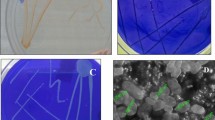Abstract
ThepcbC gene encoding (4-chloro-)2,3-dihydroxybiphenyl dioxygenase was cloned from the genomic DNA ofPseudomonas sp. P20 using pKT230 to construct pKK1. A recombinant strain,E. coli KK1, was selected by transforming the pKK1 intoE. coli XL1-Blue. Another recombinant strain,Pseudomonas sp. DJP-120, was obtained by transferring the pKK1 ofE. coli KK1 intoPseudomonas sp. DJ-12 by conjugation. Both recombinant strains showed a 23.7 to 26.5 fold increase in the degradation activity to 2,3-dihydroxybiphenyl compared with that of the natural isolate,Pseudomonas sp. DJ-12. The DJP-120 strain showed 24.5, 3.5, and 4.8 fold higher degradation activities to 4-chlorobiphenyl, catechol, and 3-methylcatechol than DJ-12 strain, respectively. The pKK1 plasmid of both strains and their ability to degrade 2,3-dihydroxybiphenyl were stable even after about 1,200 generations.
Similar content being viewed by others
References
Chaudhry, G. R. and S. Chapalamadugh (1991) Biodegradation of halogenated organic compounds.Microbiol. Rev. 55: 59–79.
Mars A. E., T. Kasberg, S. R. Kaschabek, M. H. van Agteren, D. B. Janssen, and W. Reineke (1997) Microbial degradation of chloroaromatics; use of themeta-cleavage pathway for mineralization of chlorobenzene.J. Bacteriol. 179: 4530–4537.
Dowling, D. N., R. Pipke, and D. F. Dwyer (1993) A DNA module encodingbph genes for the degradation of polychlorinated biphenyls (PCBs).FEMS Microbiol. Lett. 113: 149–154.
Cerdan, P., A. Wasserfallen, M. Rekik, K. N. Timmis, and S. Harayama (1994) Substrate specificity of catechol 2,3-dioxygenase encoded by TOL plasmid pWWO ofPseudomonas putida and its relationship to cell growth.J. Bacteriol. 176: 6074–6081.
Carrington, B., A. Lowe, L. E. Shaw, and P. A. Williams (1994) The lower pathway operon for benzoate catabolism in biphenyl-utilizingPseudomonas sp. strain IC and the nucleotide sequence of thebphE gene for catechol 2,3-dioxygenase.Microbiology 140: 499–508.
Weightman, A. J., R. H. Don, P. P. Lehrach, and K. N. Timmis (1984) The identification and cloning of genes encoding haloaromatic catecholic enzymes and the construction of hybrid pathways for substrate mineralization. pp. 47–88. In: G. S. Omenn and A. Hollaender (eds.),Genetic Control of Environmental Pollutants. Plenum Press, New York, USA.
Adams, R. H., C.-M. Huang, F. K. Higson, V. Brenner, and D.D. Focht (1992) Construction of 3-chlorobiphenyl-utilizing recombinant from an intergenic mating.Appl. Environ. Microbiol. 58: 647–654.
Hirose, J., A. Suyama, S. Hayashida, and K. Furukawa (1994) Construction of hybrid biphenyl (bph) and toluene (tod) genes for functional analysis of aromatics ring dioxygenase.Gene 138: 27–33.
Furukawa, K., J. Hirose, S. Hayashida, and K. Nakamura (1994) Efficient degradation of trichloroethylene by a hybrid aromatic ring dioxygenase.J. Bacteriol. 176: 2121–2123.
Ogawa, N. and K. Miyashita (1995) Recombination of a 3-chlorobenzoate catabolic plasmid fromAlcaligenes outrephus NH9 mediated by directed repeat elements.Appl. Environ. Microbiol. 61: 3788–3795.
Seeger, M., K. N. timmis, and B. Hofer (1995) Conversion of chlorobiphenyls into phenylhexadienoates and benzoates by the enzymes of the upper pathway for polychlorobiphenyl degradation encoded by thebph locus ofPseudomonas sp. strain LB400.Appl. Environ. Microbiol. 61: 3654–2658.
Kim, E., Y. Kim, and C. K. Kim (1996) Genetic structure of the genes encoding 2,3-dihydroxybiphenyl 1,2-dioxygenase and 2-hydroxy-6-oxo-6-phenylhexa-2,4-dienoic acid hydrolase from biphenyl- and 4-chlorobiphenyl-degradingPseudomonas sp. strain DJ-12.Appl. Environ. Microbiol. 62: 262–265.
Kim, J. W., C. K. Kim, Y. C. Kim, J. H. Yum, and J. K. Lee (1987) Isolation and characterization of bacteria degrading chlorinated aromatic hydrocarbons.Kor. J. Micorbiol. 25: 122–128.
Kim, C. K., E. Kim, J. C. Chae, and Y. Kim (1996) Structure of thepcbC gene encoding 2,3-dihyroxybiphenyl dioxygenase ofPseudomonas sp. P20.Biochem. Biophys. Res. Comm. 226: 15–20.
Sambrook, J., E. E. Fritsch, and T. Maniatis (1989)Molecular Cloning: A Laboratory Manual. 2nd ed., Cold Spring Harbor Laboratory, Cold Spring Harbor, New York, USA.
Nam, J. H., H. M. Oh, and C. K. Kim (1995) Cloning and expression ofpcbC andpcbD genes responsible for 2,3-dihydroxybiphenyl degradation fromPseudomonas sp. P20.J. Microbiol. Biotechnol. 5: 68–73.
Top, E., I. D. Smet, W. Verstrate, R. Dijkmans, and M. Mergeay (1994) Exogenous isolation of mobilizing plasmids from polluted soils and sludges.Appl. Environ. Microbiol. 60: 831–839.
Lee, J., K. Jung, S. H. Choi, and H. Kim (1995) Combination of thetod andtol pathways in redesigning a metabolic route ofPseudomonas putida for the mineralization of a benzene, toluene, andp-xylene mixture.Appl. Environ. Microbiol. 61: 2211–2217.
Kimbara, K., T. Hashimoto, M. Fukuda, T. Koana, M. Takagi, M. Oishi, and K. Yano. (1989) Cloning and sequencing of two tandem genes involved in degradation of 2,3-dihydroxybiphenyl to benzoic acid in the polychlorinated biphenyl-degrading soil bacteriumPseuaomonas sp. strain KKS102.J. Bacteriol. 171: 2740–2747.
Author information
Authors and Affiliations
Corresponding author
Rights and permissions
About this article
Cite this article
Kim, JY., Kim, Y., Lee, K. et al. Improved degradation of 4-chlorobiphenyl, 2,3-dihydroxybiphenyl, and catecholic compounds by recombinant bacterial strains. Biotechnol. Bioprocess Eng. 6, 56–60 (2001). https://doi.org/10.1007/BF02942251
Received:
Accepted:
Issue Date:
DOI: https://doi.org/10.1007/BF02942251




